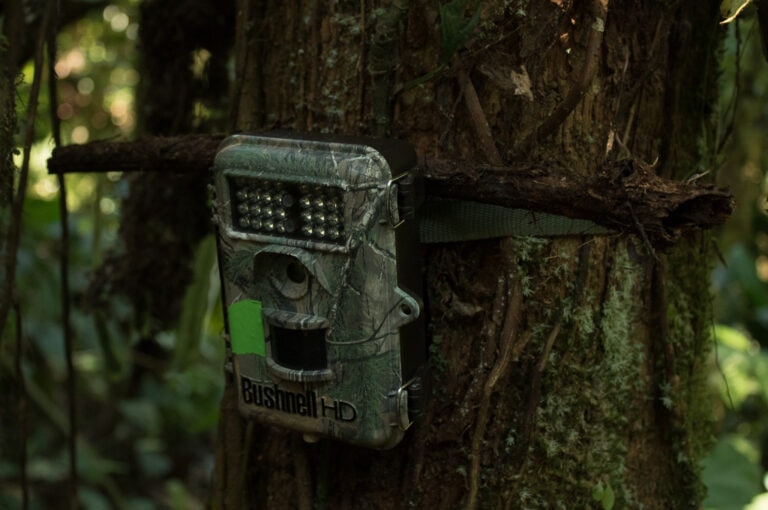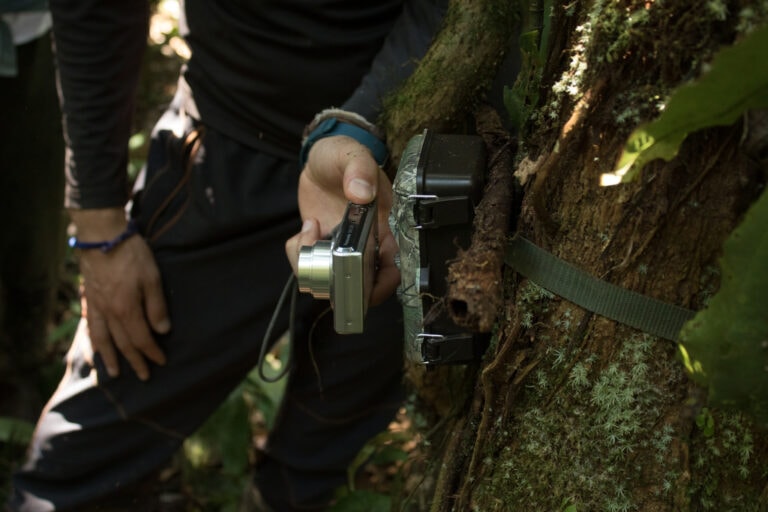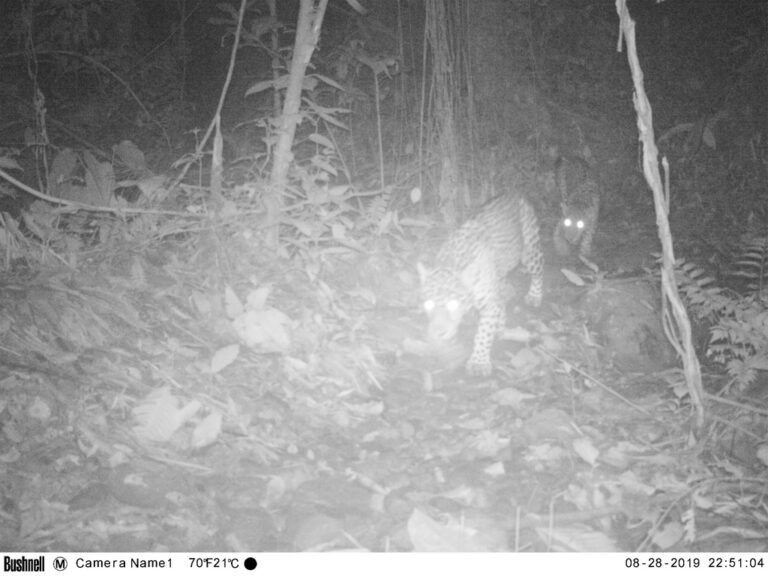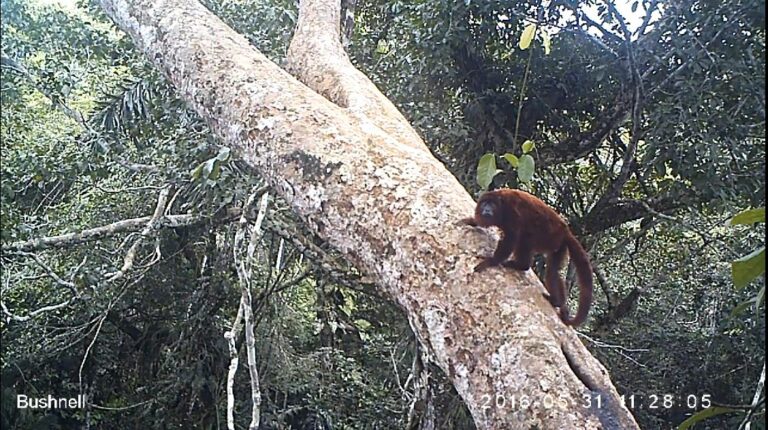
Camera traps: a gateway into a hidden world allowing us to explore the habits of wildlife that may be otherwise inaccessible to many of us!
By Daniel Ash with further contributions from Sr. Juan Carlos Cardenas and Sergio Goizeder
For most people observing wildlife usually comes at the cost of fitting it in around our busy schedules that are an unavoidable part of modern life, alongside the restrictions of our body clocks. Many of the more elusive animals of the Amazon, larger mammals especially, naturally tend to be more active during dusk and dawn, give or take a few hours on either side.
This is mainly due to the intense heat throughout the day as well as the potential threat of encountering humans (when this happens, wildlife tends to stop their movements, routines, or hunting activities, which is a shame) so the question remains – how do we capture these species going about their business?
Their highly tuned senses usually mean that they can avoid us throughout daylight hours so we can try as much as we like to attempt to wait around all day to no avail. This is where the camera trap comes in, it is a motion-activated camera, cased in a weatherproof box capable of recording either photo or video (even both depending on the model you purchase). Which has been weatherproofed ready for being left out for long periods of time out in the field.

The art of positioning the trap is what will determine your success as there are a number of factors to consider which come into play when leaving the equipment out for long periods of time:-
Stable base point – The main thing to consider is where you will place your trap and what it will be secured to. Think about your perspective from the cameras point of view as it could be the difference between a few seconds of footage & poor photos to brilliant full length clips and high quality captures. i.e. is it pointing down trail for longer footage? Or across trail where the animal exposure time will be less
The Environment – Is it next to a body of water that may flood? Are the trees susceptible to falling in the wind? Is there any foliage that could interfere with the shot? The people factor – could someone find and steal this trap? These are all points to consider when placing your trap so it is important to ensure that the camera blends in with the environment seamlessly
Timescale – It is important to plan & decide upon the length of time you will be leaving your trap out in the elements. Longer periods of time leave it more susceptible to theft or damage but also increases the likelihood of better footage due to being left out undisturbed, allowing time for your scent to dissipate which may be picked up on by the animals. Which brings me to…
The Balance of Settings – Depending on your make and model you will want to decide on what type of footage you wish to capture whether it be images, video or both. This will depend on the point mentioned previously about how long you intend to leave the trap out. Longer periods may call for shorter video capture time, higher intervals between captures to avoid it being set off repeatedly by unwanted sources and adjusting the sensor sensitivity to avoid it being activated by a gust of wind or insects speeding past all in an attempt to preserve battery life. Another thing to consider on the photo side of things is whether to have a singular shot or burst, as a general rule it is better to have a burst (usually around 3 shots) to ensure the best chances of getting great photos!

What other problems can we have? Firstly, humidity is something to take into account, places like tropical forests constantly present these levels, which can directly damage the camera and the sensor.
What can we do? depending on the model of the camera we can use gel or another anti-humidifier. It is also important to take into account ants and termites, which can permanently damage equipment; unfortunately, it is something that we cannot avoid.
To summarise, Camera Traps are a brilliant way to capture situations and wildlife we usually wouldn’t see which is why they are such an important tool in terms of conservation; allowing us to keep track of animals that may be unbeknownst to us so that we can add these sightings to important survey data and help us learn more about the behaviours of the wildlife we are looking to preserve & protect!
Catching these animals unaware helps shed them in a different light to us and the general public, which helps establish a better emotional connection, some of the behaviours documented between individuals can even be very reminiscent of humans!
Apart from that, the footage we capture is usually extremely interesting & informative at the very least, sometimes funny and unbelievably cool!
Camera trapping in the field
by Sergio Goizeder (Crees Senior Biologist)
“How did the idea of using camera traps in an investigation come about? Firstly, the intention of knowing the diversity of remote areas, especially those in which access and stay are very limited. However, with enough time and the necessary resources, 16 camera traps were installed.
From the fact of preparing the equipment, and preparing the food, because naturally, you have to camp; and above all, verifying that the cameras have the necessary conditions is of the utmost importance.
During the trip, you just want to get off the boat and find a good place, with good light and some indications that the animals are constantly going through these areas, to then be able to install these wonderful machines and pray somehow that you don’t have more factors to deal with at the time of recording.
Thus, after the field phase, a well-deserved rest by the river never hurts. And even more so, knowing that in 3 months you have to return to see the result of all our work. To then, after 3 months, return and find the cameras in good condition is a sigh of relief, and even more so, knowing that they have recorded a lot of activity in all the time they were there.
The peak moment has arrived, to review the memories of the cameras and to find ourselves the surprise… they have recorded the most elusive animals there are: Jaguars, ocelots, pumas, tapirs, and others; all going about their daily activities and acting naturally in front of the cameras.
It is beautiful to observe how all the effort will result in showing the world the wonderful animals that we have and that we have to conserve, we hope that more results will show us much more of the interactions that these animals carry out.
From our personal experience, we can say that working with camera traps is extremely important for the conservation of a very interesting experience in the development of research, as well as knowing the different species that inhabit the area!”

An unforgettable memory…
by Sr. Juan Carlos Cardenas (Crees General Manager)
“A few years ago, our cameras captured a male howler monkey on video very close to the native community of Shipitieri. These monkeys typically emit loud sounds every morning to mark their territory, but the native people are accustomed to hunting and consuming them as part of their diet.
We were afraid that these monkeys were no longer present in the community, but the video from the camera trap showed a male howler monkey making the gesture of emitting the sound, but without the actual sound. It was then that we realized the potential for that, in order to survive, the howler monkeys had stopped making their calls to stay alive. Thus showing the importance and power of camera traps to improve our knowledge of local areas and their biodiversity.
We are in search of high-tech camera traps to further contribute to conservation efforts, capturing astonishing images and videos. From charming hummingbirds to majestic jaguars, these camera traps will enable us to learn and protect these fascinating species, while sharing the wonderful wildlife that inhabits our Manu Learning Centre with the entire world. We are eager to establish meaningful partnerships with companies manufacturing camera traps, who will join our noble cause in preserving the beauty and diversity of our natural environment. This collaboration will be instrumental in fostering environmental awareness and safeguarding our precious ecosystem”
If collaboration in this respect is of interest to you please contact – data@crees-manu.org
We have included plenty of information in this blog to get you well on your way to starting your camera trap journey, or hopefully, at least, we have helped improve your knowledge!
For more camera trap images and footage keep an eye on our social media sites! Or alternatively, you can check out www.zooniverse.org
Stay tuned for part 2! Where we will talk further about DSLR camera traps
With thanks to our contributors:-
Daniel Ash (Crees Multimedia Coordinator) and of www.danielashphotography.co.uk and @danielashphoto on Instagram
Sergio Goizedor (Crees Senior Biologist) – @goizeder_sergio on Instagram
Sr. Juan Carlos Cardenas (Crees General Manager) – @juancarloscardenas7578 on Instagram


